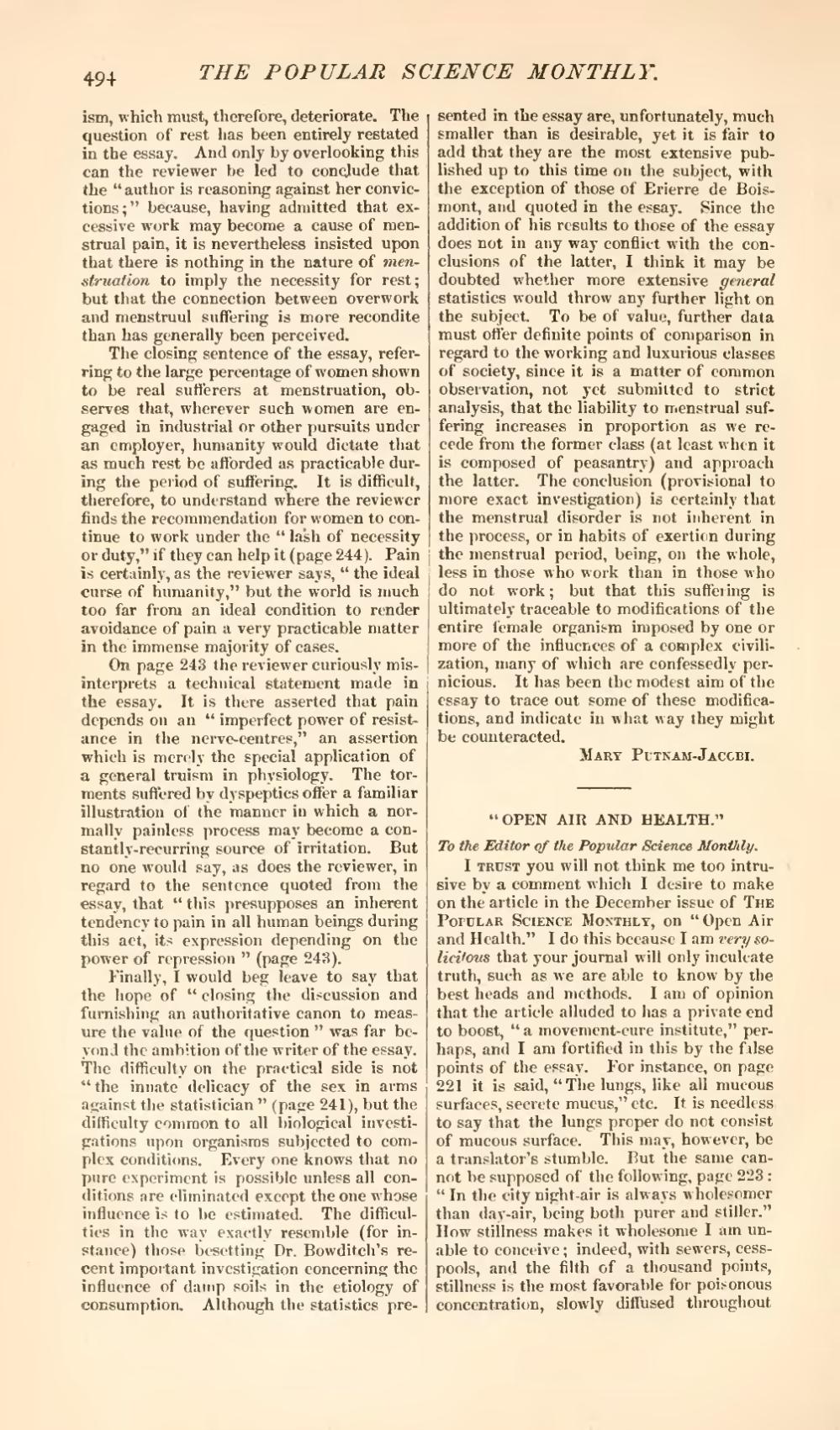ism, which must, therefore, deteriorate. The question of rest has been entirely restated in the essay. And only by overlooking this can the reviewer be led to conclude that the "author is reasoning against her convictions;" because, having admitted that excessive work may become a cause of menstrual pain, it is nevertheless insisted upon that there is nothing in the nature of menstruation to imply the necessity for rest; but that the connection between overwork and menstruul suffering is more recondite than has generally been perceived.
The closing sentence of the essay, referring to the large percentage of women shown to be real sufferers at menstruation, observes that, wherever such women are engaged in industrial or other pursuits under an employer, humanity would dictate that as much rest be afforded as practicable during the period of suffering. It is difficult, therefore, to understand where the reviewer finds the recommendation for women to continue to work under the "lash of necessity or duty," if they can help it (page 244). Pain is certainly, as the reviewer says, "the ideal curse of humanity," but the world is much too far from an ideal condition to render avoidance of pain a very practicable matter in the immense majority of cases.
On page 243 the reviewer curiously misinterprets a technical statement made in the essay. It is there asserted that pain depends on an "imperfect power of resistance in the nerve-centres," an assertion which is merely the special application of a general truism in physiology. The torments suffered by dyspeptics offer a familiar illustration of the manner in which a normally painless process may become a constantly-recurring source of irritation. But no one would say, as does the reviewer, in regard to the sentence quoted from the essay, that "this presupposes an inherent tendency to pain in all human beings during this act, its expression depending on the power of repression" (page 243).
Finally, I would beg leave to say that the hope of "closing the discussion and furnishing an authoritative canon to measure the value of the question" was far beyond the ambition of the writer of the essay. The difficulty on the practical side is not "the innate delicacy of the sex in arms against the statistician" (page 241), but the difficulty common to all biological investigations upon organisms subjected to complex conditions. Every one knows that no pure experiment is possible unless all conditions are eliminated except the one whose influence is to be estimated. The difficulties in the way exactly resemble (for instance) those besetting Dr. Bowditch's recent important investigation concerning the influence of damp soils in the etiology of consumption. Although the statistics presented in the essay are, unfortunately, much smaller than is desirable, yet it is fair to add that they are the most extensive published up to this time on the subject, with the exception of those of Brierre de Boismont, and quoted in the essay. Since the addition of his results to those of the essay does not in any way conflict with the conclusions of the latter, I think it may be doubted whether more extensive general statistics would throw any further light on the subject. To be of value, further data must offer definite points of comparison in regard to the working and luxurious classes of society, since it is a matter of common observation, not yet submitted to strict analysis, that the liability to menstrual suffering increases in proportion as we recede from the former class (at least when it is composed of peasantry) and approach the latter. The conclusion (provisional to more exact investigation) is certainly that the menstrual disorder is not inherent in the process, or in habits of exertion during the menstrual period, being, on the whole, less in those who work than in those who do not work; but that this suffering is ultimately traceable to modifications of the entire female organism imposed by one or more of the influences of a complex civilization, many of which are confessedly pernicious. It has been the modest aim of the essay to trace out some of these modifications, and indicate in what way they might be counteracted.
Mary Putnam-Jacobi.
"OPEN AIR AND HEALTH."
To the Editor of the Popular Science Monthly.
I trust you will not think me too intrusive by a comment which I desire to make on the article in the December issue of The Popular Science Monthly, on "Open Air and Health." I do this because I am very solicitous that your journal will only inculcate truth, such as we are able to know by the best heads and methods. I am of opinion that the article alluded to has a private end to boost, "a movement-cure institute," perhaps, and I am fortified in this by the false points of the essay. For instance, on page 221 it is said, "The lungs, like all mucous surfaces, secrete mucus," etc. It is needless to say that the lungs proper do not consist of mucous surface. This may, however, be a translator's stumble. But the same cannot be supposed of the following, page 223: "In the city night-air is always wholesomer than day-air, being both purer and stiller." How stillness makes it wholesome I am unable to conceive; indeed, with sewers, cesspools, and the filth of a thousand points, stillness is the most favorable for poisonous concentration, slowly diffused throughout
